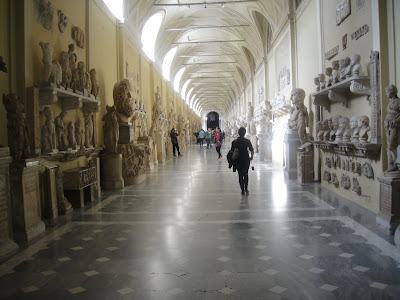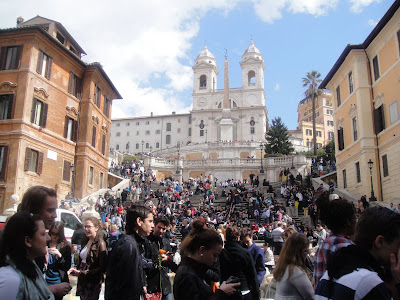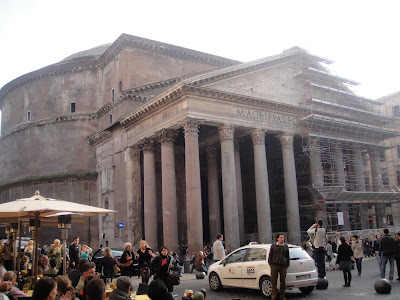
The dome of the Panteon was the largest masonry vault ever built. The incredible pleasing sense of proportion is produced by the fact that the height and diameter of the building are exactly the same-43.3 meters.

The living quaters of the Pope.

St. Peter's Basilica.
St. Peter's Square is often filled with people who come to see the pope or attend Christian celebrations. They were preparing for Easter celebrations.

The Swiss Guards are maintained by the Holy See and are responsible for the safety of the Pope and the entrances to the Vatican City.

On Sundays at midday, the Pope recites the Angelus from this window which towers above the piazza.

St. Peter's Basilica is the most important Roman Catholic church in the world.

Beneath Michelangelo's great dome is the huge Baroque baldacchino built by Bernini with magnificent gilt-bronze twisted columns supporting an elaborate canopy.


The elaborate canopy was made from bronze melted down from the ceiling of the Pantheon's porch.

Pieta was the only sculpture Michelangelo ever signed and we made in 1499 when he was just 24. It looks touchingly small and fragile amongst the magnificence of the church. Modonna appears to be younger than her Son, but she is also larger than Him.

The Sistine Chapel was named after Pope Sixtus IV who ordered its construction in 1475 and has since been used during the conclaves to elect a new Pope. Carried out in just four years, Michelangelo painted the Chapel using a small scaffolding platform without any sketching.
The Raphael Rooms are a series of four rooms decorated with frescoes by Raphael. School of Athens symbolizes the triumph of philosophy. The two greastest philosophers, Plato and Aristotle stand on the steps of the magnificently vaulted Palace of Science.

The hall of ancient Roman maps.

Laocoon is an expressive sculptural group of the priest of Troy with his two sons caught in the coils of the serpents sent by Apollo to crush them to death.

The hall of ancient Roman sculptures.

Ancient Roman frescoes.

The Tiber River.

The Spanish Steps.



The Pantheon is one of the most remarkable buildings in all the ancient world. The Pantheon was dedicated to all the gods and was conceived as a secular imperial monument as much as a shine. It was converted into a church in 609.
The Ecstasy of St. Teresa sculpted by Bernini in the church of Santa Maria della Vittoria.

Santa Maria della Vittoria remains one of the most complete examples of Baroque decorations in all Rome.

Flower markets were on the corner of every street.
The Catacombs of San Callisto was the first offiecial cemetary of the early Christian community. Since space was at a premium, and the soft tufa so easy to quarry, the cemetreries expanded underground. The bodies were placed in wrapped sheets in a hole in the wall, which was then closed with slabs of marble or terracotta. The Catacombs of San Callisto is the largest of the many catacombs of Rome which expand over 11 miles underground.

The Fountain of Trevi is fed by an aquaduct built by Agrippa in 19 BC. It is tradition to throw a coin over your shoulder into the fountain to ensure your return to Rome someday.

The Roman Forum was the heart of the ancient city where Romans would come to see the magnificent temples and triumphal arches. The Roman Forum was were political assemblies were held, where orators would address the people, where the senate met, where courts of justice sat in the basilicas, and where the main religious festivals took place.

Roman Forum ruins.

The Arch of Constantine was erected in 315 in honor of Constantine's victory over a rival emperor, Maxentius.

The Colosseum could hold more than 50,000 spectators. The floor of the Colosseum has disappeared but the vaults which support the shafts where the mechanism for the scenery were kept can still be seen. The interior was filled with tiers of seats which no longer exist. However, you can still see the substructures which supported them and the vaulted passageways which provided access to them.

The Colosseum is the largest amphitheater ever built by the Romans. The Colosseum was begun by Vespasian in 70 AD. and completed ten years later by his son Titus. Romans enjoyed coming to the Colosseum to see gladiators fight man to man in single combat until one was killed, or wild animals, including crocodiles, lions, elephants and tigers.


The Colosseum used 80 entrances in which spectators could reach their seats. Over 200 wooden poles could be inserted around the top of the structure that gave support to a huge awning which protected the audience from the sun.




Outdoor market

Dinner with Deanna and Ty.


We stayed the night with a family friend in Tallinn before our trip to Rome. She is a "couch surfer" which is where people from around the world travel and you let them stay with you as they make their journey. She had a large map on her floor and everytime she has someone stay with her, she lets them put a pin in the map of where they live. We got to put pins in Nebraska!











No comments:
Post a Comment